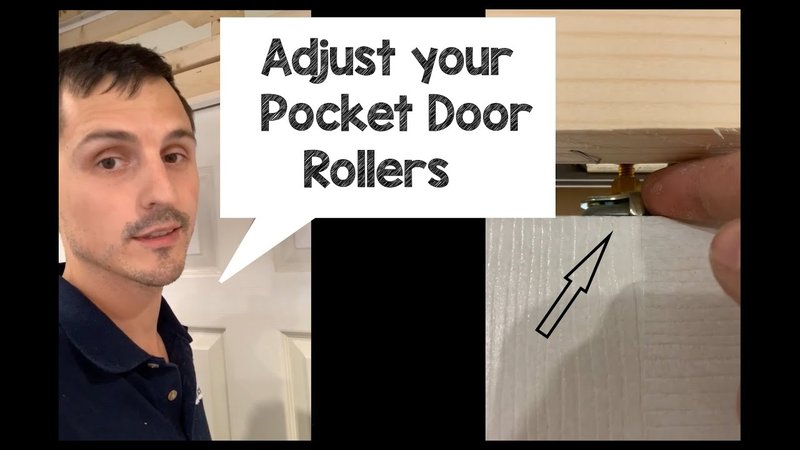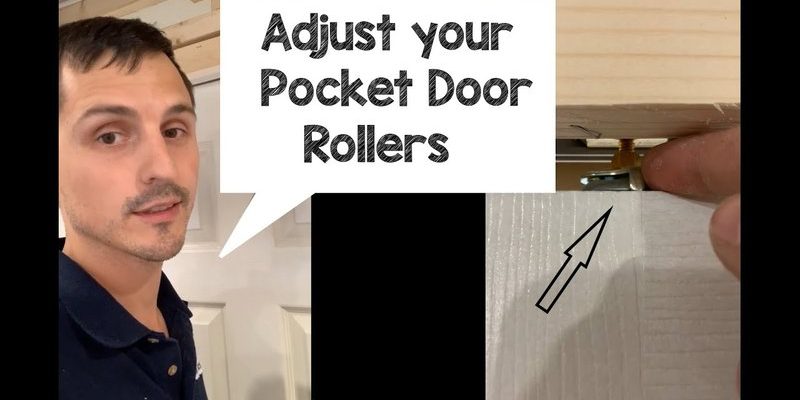
Imagine your pocket door is like a favorite book hidden on a shelf. You want to pull it out smoothly whenever you need it, but if the hardware isn’t adjusted properly, it can stick or even jam. This guide will walk you through the process of adjusting that bypass hardware so your door operates seamlessly. Even if you’re new to DIY projects, this step-by-step approach makes it easy to tackle.
Understanding Pocket Door Bypass Hardware
Pocket door bypass hardware is designed to allow doors to slide into a wall for a clean, unobtrusive look. Typically, when we talk about a specific brand—say, Johnson Hardware—the system consists of rollers, tracks, and various adjustment mechanisms. Each part plays a crucial role in ensuring your door opens and closes smoothly.
What’s essential here is knowing how these components interact. The rollers attach to the door and glide along the track, while the track is installed in the wall. If something goes wrong—like the door not sliding properly—you’ll need to adjust these components. It’s like tuning a guitar: just a small twist here or there can make a significant difference.
You might be wondering why adjustments are necessary. Over time, wear and tear can cause the door to become misaligned or stuck. Changes in humidity and temperature can also affect how the door operates, so it’s good practice to check and adjust your pocket door bypass hardware occasionally.
Gathering the Right Tools
Before diving into adjustments, make sure you have the right tools handy. This will save you time and keep the process smooth. Here’s what you’ll typically need:
- Screwdriver (flathead and Phillips)
- Adjustable wrench (for loosening hardware)
- Level (to ensure proper alignment)
- Measuring tape (for precise measurements)
Having these tools on hand will make the job easier, and you won’t have to run back and forth to gather what you need. Honestly, there’s nothing more annoying than realizing you need a screwdriver halfway through a project.
Also, consider wearing safety glasses if you’re working with any hardware that requires cutting or heavy lifting. Better safe than sorry!
Locating the Adjustment Mechanism
Now that you have your tools, it’s time to locate the adjustment mechanism on your specific pocket door bypass hardware. Look for small screws or knobs on the rollers or the track. These are typically what you’ll adjust to change the height or alignment of the door.
For most brands, the adjustment screws are located at the top of the roller assembly or along the track. If you’re working with a brand like Johnson Hardware, the adjustment could be a simple turning mechanism that raises or lowers the door.
Here’s the thing: if you can’t see the adjustment screws at first glance, don’t panic. Sometimes they can be tucked away or a little hidden. Just take a moment to inspect the setup. And remember, patience is key here!
Making Height Adjustments
Adjusting the height of your pocket door is a straightforward process but is vital for optimal performance. Start by inspecting how the door sits in the frame. If it’s dragging, you’ll likely need to raise it slightly. Here’s how to do it:
1. Loosen the screws on the roller assembly. Don’t remove them completely—just loosen them enough to let the rollers move.
2. Turn the adjustment screw clockwise to raise the door or counterclockwise to lower it. Keep adjusting until the door is level with the surrounding frame.
3. Check the alignment with a level to ensure it’s straight.
Once you’re satisfied with the height, tighten the screws back up securely. Make sure the door operates smoothly before declaring victory. A small adjustment now could save you from headaches later!
Aligning the Track and Door
If your door is still sticking after adjusting the height, it might be misaligned with the track. Correctly aligning your door is essential for seamless operation. Follow these steps:
1. Open the door fully and inspect the space between the door and the wall. It should sit evenly.
2. If there’s a gap, you’ll need to adjust the track. Look for adjustment screws on the track itself.
3. Loosen the track screws slightly and reposition the track as needed. You may need someone to hold the door open while you adjust for the best alignment.
Let’s keep in mind—if the track is out of alignment, it can cause major headaches down the line. A well-aligned track allows your door to move freely and prevents unnecessary wear on the hardware.
Common Troubleshooting Tips
Even with the best adjustments, you might still face some issues. Here are a few common problems you might encounter, along with ways to troubleshoot them:
– Door sticking: If your door still sticks after adjustments, check for debris in the track. Sometimes, a simple cleaning can make a huge difference.
– Noisy rollers: A squeaky door isn’t just annoying; it’s a sign that your rollers might need lubrication. Use a silicone-based lubricant on the rollers for smoother operation.
– Misalignment issues: If you find yourself adjusting frequently, you may need to consider if the door itself is warped or the hardware is damaged.
These small steps can prevent larger issues from developing, so don’t skip them.
When to Call a Professional
It’s great to tackle DIY projects yourself, but sometimes it’s wise to know when to call for help. If you’ve adjusted the pocket door bypass hardware multiple times without any luck, or if you notice significant damage to the hardware, it might be time to reach out to a professional.
Calling a pro can save you time and prevent further damage. Plus, they have the experience to troubleshoot issues that might be beyond your knowledge.
Remember, there’s no shame in asking for help, especially when it comes to home maintenance. Your pocket door is an investment in your home’s functionality and aesthetics.
Adjusting a specific brand’s pocket door bypass hardware can seem tricky at first, but it’s all about knowing the steps. From gathering your tools to making precise adjustments, each stage is manageable with a little patience and practice.
By ensuring your door operates smoothly, you enhance not just the functionality of your space but also its overall appeal. You’ve got this! So, the next time you spot a sticky or misaligned pocket door, remember these steps, and your door will glide into the wall like it was meant to. Happy adjusting!
